Updated: April 16, 2023.
Learn how to find duplicate content on your website with the help of JetOctopus.
In this guide, I’ll show you how to find duplicate content on your website and explain why it’s important to stay aware of any potential issues.
Although duplicate content isn’t always a problem, it’s good to keep an eye on it and assess whether it needs addressing.
I’ll also provide some solutions for fixing duplicate content issues and include an FAQ section that covers a range of topics related to duplicate content.
By the end, you’ll have a solid understanding of how to maintain your website’s content uniqueness and optimize it for SEO.
Let’s dive into it!
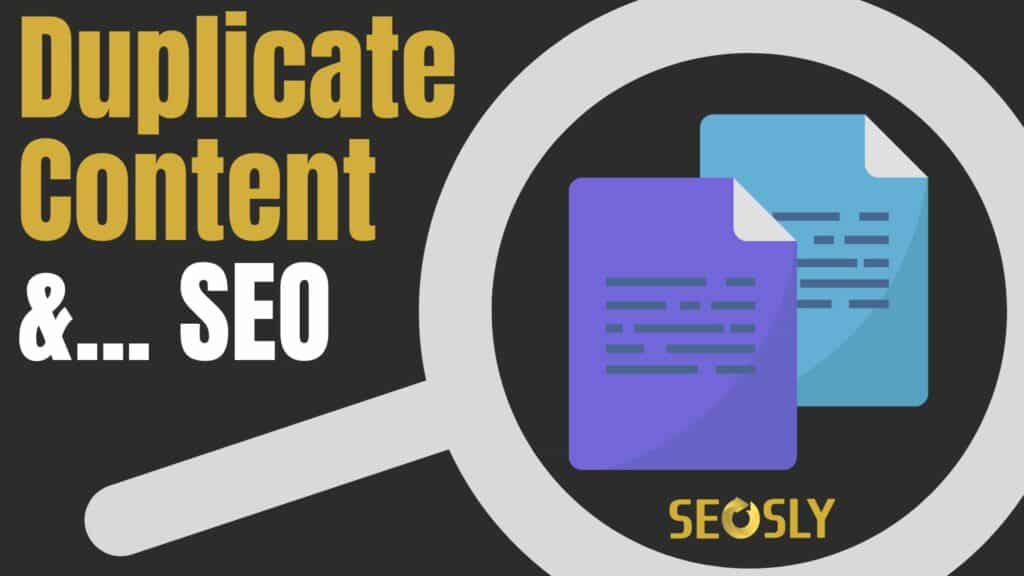
TL;DR: How to fund duplicate content on your website
To quickly find if your website has duplicate content, simply crawl it with a website crawler like JetOctopus. Once the crawl is complete, navigate to the Duplication report and review the duplicate content issues on your website.
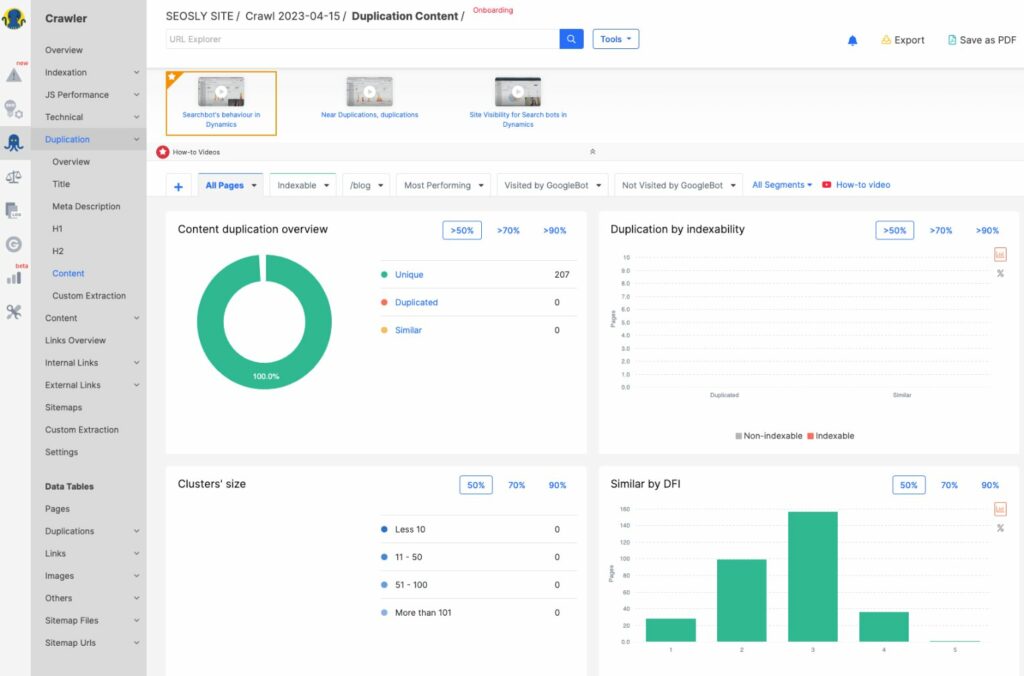
What is duplicate content?
Duplicate content refers to content that is either exactly the same or very similar and appears on more than one web page. This can cause problems for search engines as they try to decide which version to rank or display in search results.
There are different types of duplicate content you should be aware of:
- Exact duplicates are when the content is completely identical across multiple pages. This can happen due to copy-pasting or technical issues like having the same content on different URLs.
- Near duplicates are when the content is almost the same but with slight variations, such as rewording or changing the order of paragraphs. This can occur when multiple pages cover the same topic but are not exactly the same.

Of course, duplication doesn’t only affect the body content of your website; it can also impact crucial on-page SEO elements such as:
- Meta titles: The meta title is the clickable headline displayed in search engine results pages (SERPs) for a given webpage.
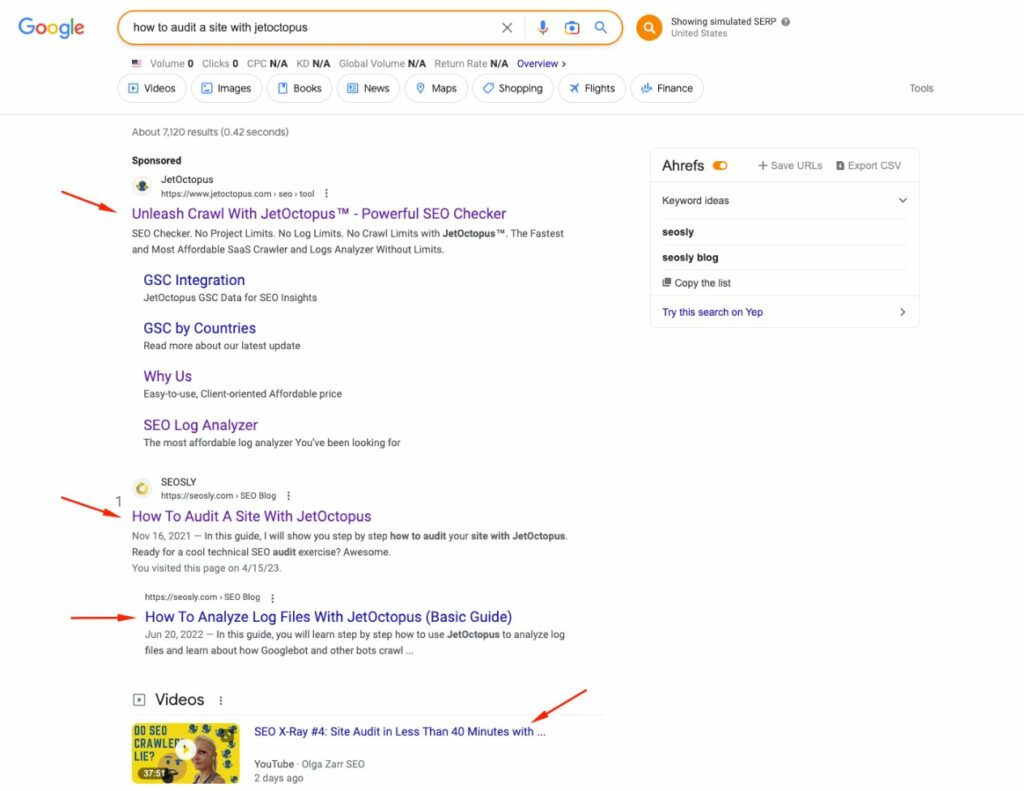
It helps users and search engines understand the topic of your page. Having duplicate meta titles can confuse search engines and negatively affect your rankings, as they may struggle to differentiate between pages with the same titles.
Of course, Google likes to rewrite meta titles a lot, but it is a very important signal for search engines about what the page is really about.
- Meta descriptions: The meta description is a brief summary of a webpage’s content that appears under the meta title in SERPs.

A unique and well-written meta description can improve your click-through rate (CTR) by enticing users to click on your page.
Duplicate meta descriptions may mislead search engines and users and potentially reduce our page’s perceived relevance.
Google also likes to rewrite meta descriptions a lot and meta descriptions are not a ranking factor but it is still a good practice to make them unique per page.
- H1 tags: The H1 tag is the primary heading of a webpage and is typically the title or main topic of the content. It is crucial for on-page SEO, as it helps search engines determine the focus of the page.
Duplicate H1 tags across different pages can make it difficult for search engines to understand your site’s structure and identify which pages to prioritize in search rankings.
- H2 tags: H2 tags are subheadings used to organize your content into smaller, easily digestible sections. They also help search engines understand the structure and hierarchy of your content.
Similar to H1 tags, duplicate H2 tags can cause confusion for search engines and negatively impact your website’s SEO.
What about the duplicate content penalty?
There’s a common myth about a “duplicate content penalty,” but the truth is, there’s no direct penalty from Google for having duplicate content.
If there is no penalty, then what are some of the possible negative consequences of having duplicate content?
- When search engines encounter duplicate content, they struggle to determine which version to index and show in search results. This can result in your preferred version not being displayed.
- Duplicate content can dilute your link equity, as backlinks pointing to different versions of the same content are divided among those versions. Consolidating these links into a single page would significantly improve your page’s authority and chances of ranking higher.
- Having duplicate content on your website can lead to a poor user experience. Users may become confused or frustrated if they encounter the same content on multiple pages, resulting in increased bounce rates and reduced user engagement.
- Search engines allocate a certain crawl budget to each website, which determines how many pages they’ll crawl within a specific time frame. Duplicate content can waste your crawl budget, as search engines will spend time crawling and indexing duplicate pages instead of discovering new, unique content on your site.
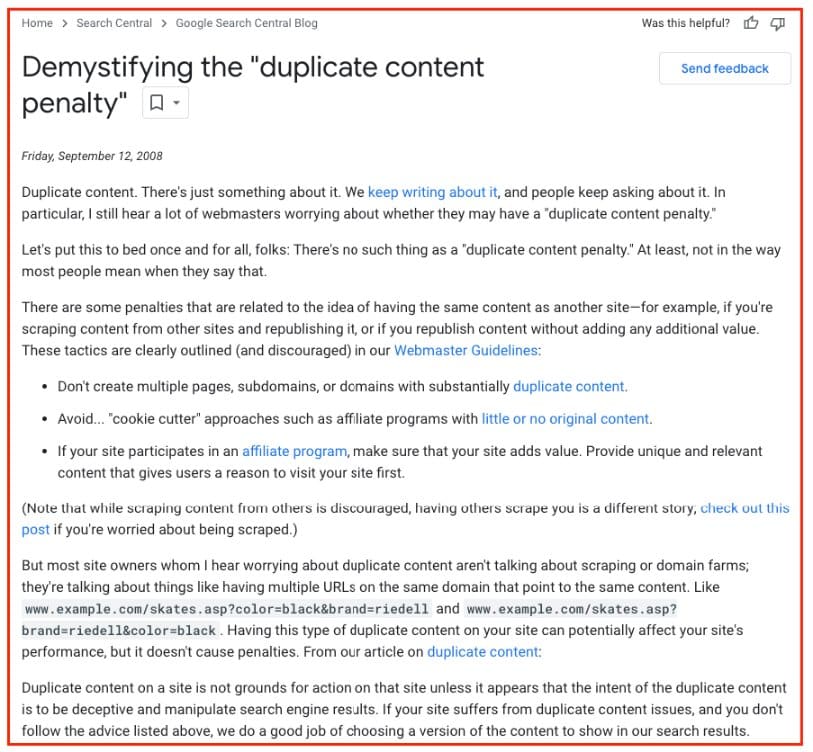
Get started with JetOctopus for free
You can use various SEO crawling tools to help you find duplicate content on the website, such as JetOctopus, Semrush Site Audit, Screaming Frog, Sitebulb, Ahrefs Site Audit, etc.
The one I am using and I invite you to use is JetOctopus which offers a free 7-day trial.
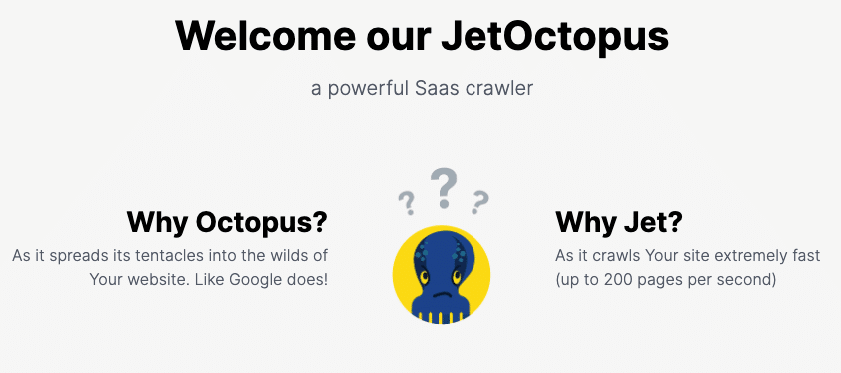
Signing up for JetOctopus is easy.
- Head to their website and click on the “free 7-day trial” button.
- Fill out the necessary information and create your account. No credit card is required for the free trial, so you can try it out without any commitment.
- Once you’ve signed up, click on “Add new website”.
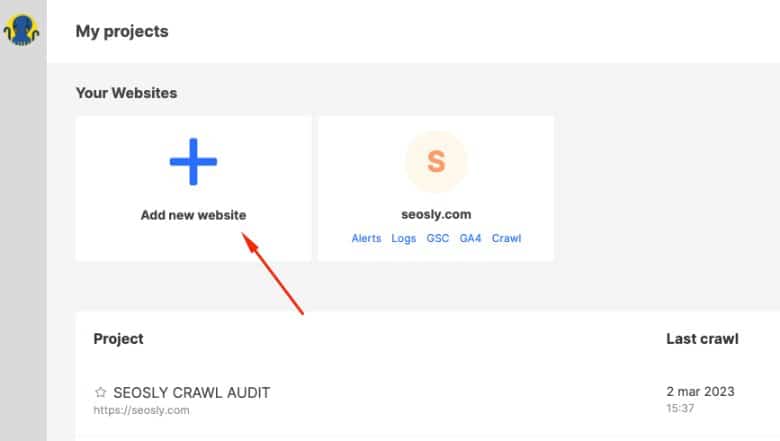
- Next, connect your website by following the steps there. The first crawl will automatically begin.
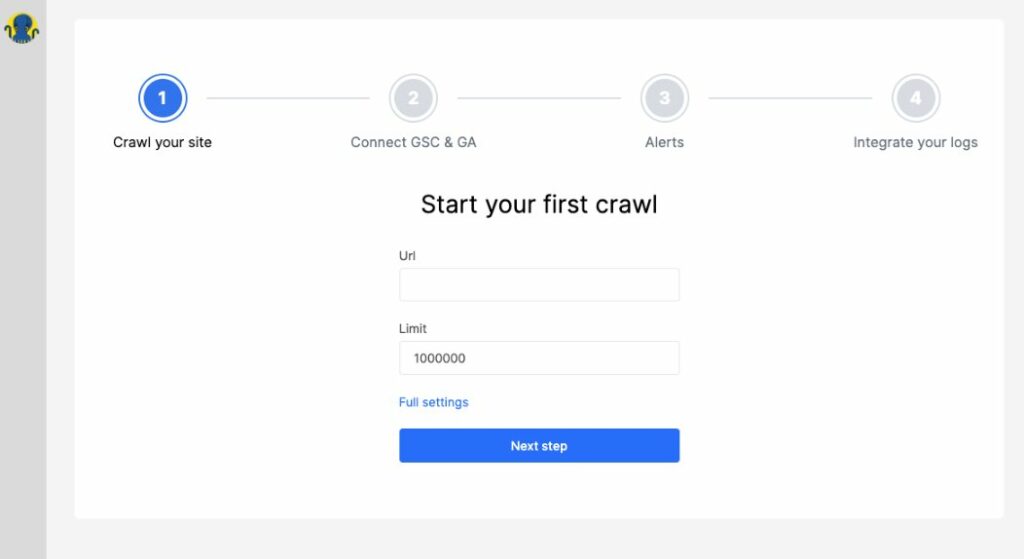
Done? Let’s now check for duplicate content.
How to find duplicate content on your website with JetOctopus
Next, follow the below steps to find duplicate content on your website.
- Click on the project you have just created. In my case, it’s “SEOSLY SITE” for the purposes of this tutorial.
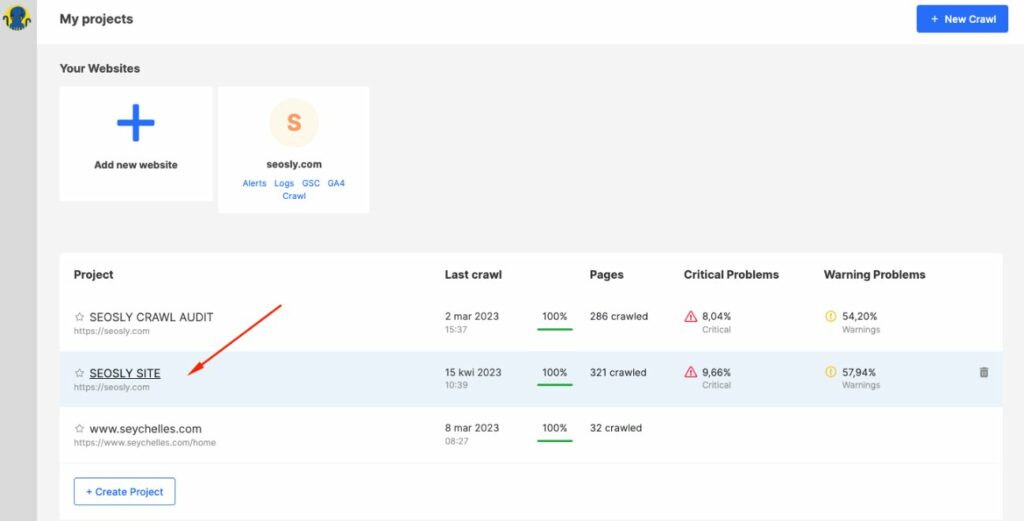
- Click on the last crawl from the Crawl list.

- Navigate to the Duplication tab (in the Crawler report).
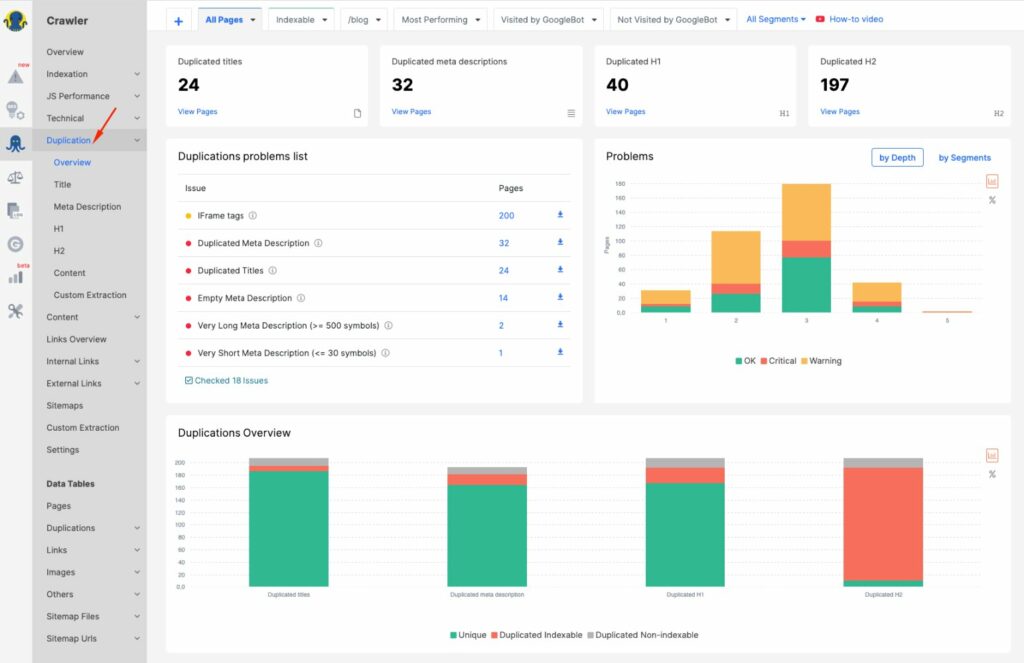
- This report is organized into different categories to help you pinpoint the exact type of duplication identified:
Duplication Overview
The Overview tab gives you a summary of all duplication issues on your site, such as duplicate titles, meta descriptions, H1, H2, and body text.
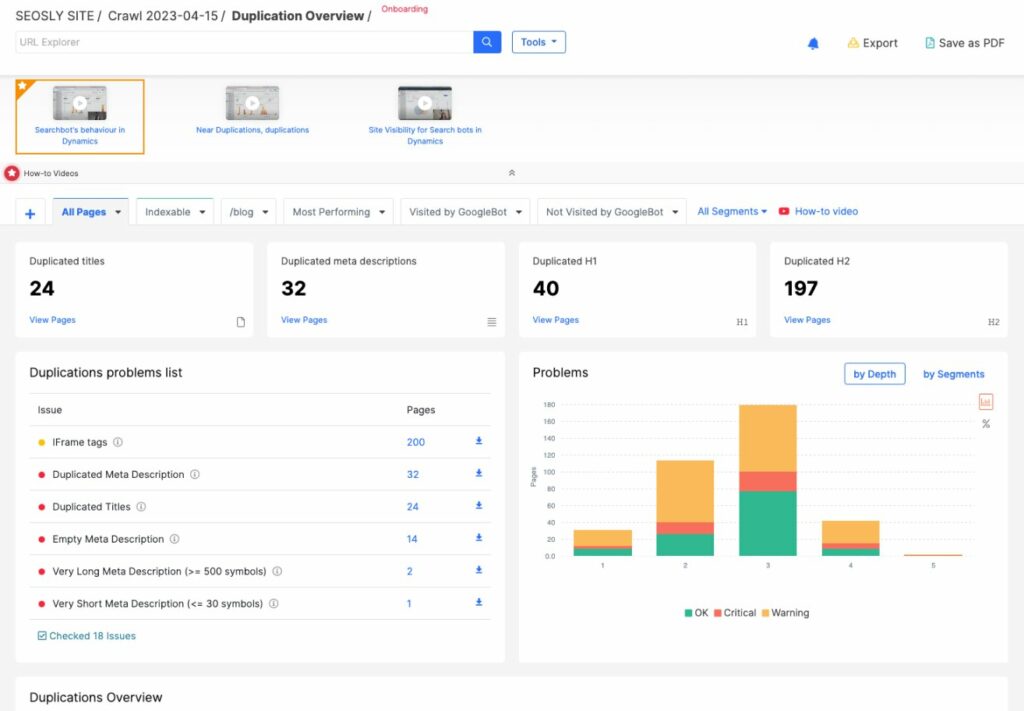
It also allows you to filter the pages with the duplicate content issue by whether it is indexable, is in a specific subfolder (like /blog), has been visited by GoogleBot, or has not been visited by GoogleBot.
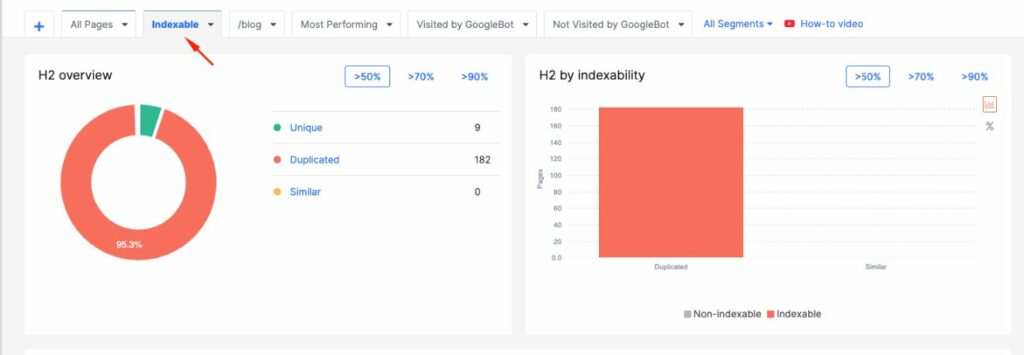
Duplicate Titles
This tab displays a list of pages with identical or similar page titles. You can also filter them in the same way you could filter the page in the Overview report.
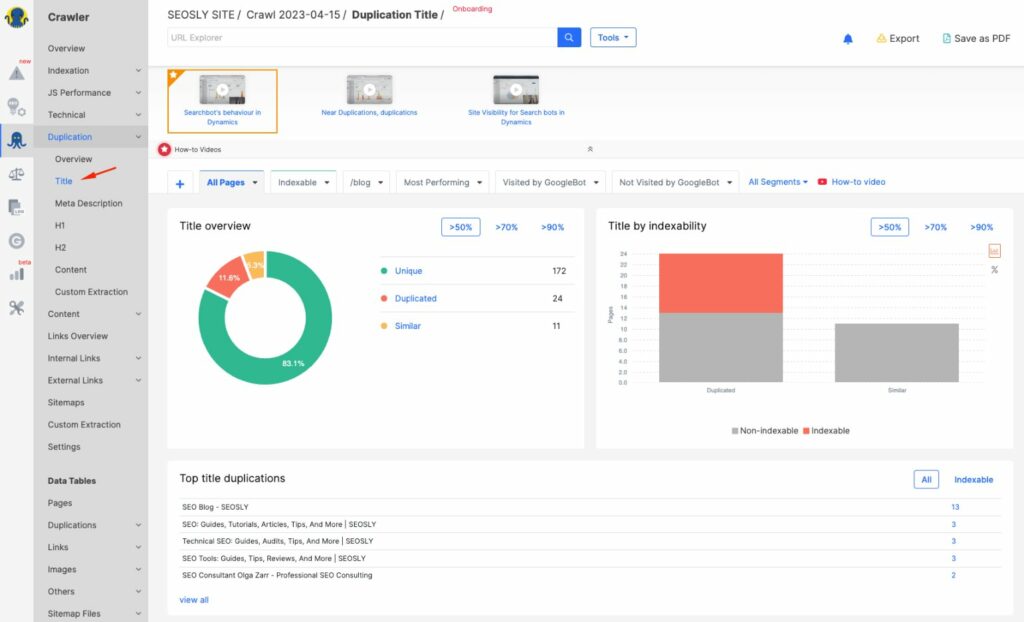
Duplicate Meta Descriptions
In this tab, you’ll find pages with duplicate or near-duplicate meta descriptions.
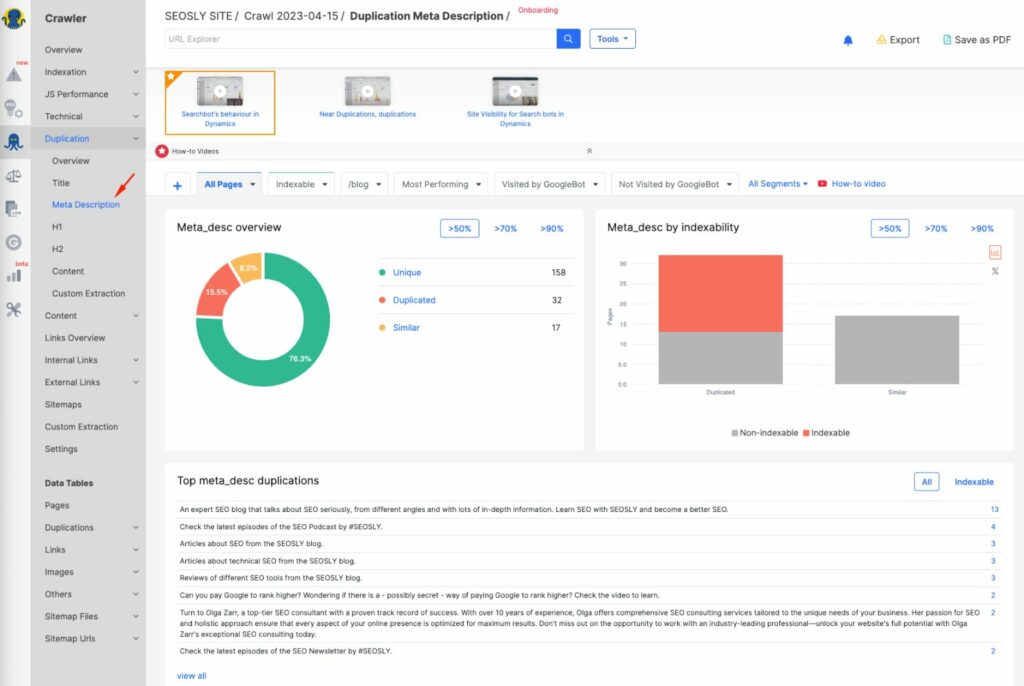
Duplicate H1
If you have pages with identical H1 tags, they will show up in this tab.
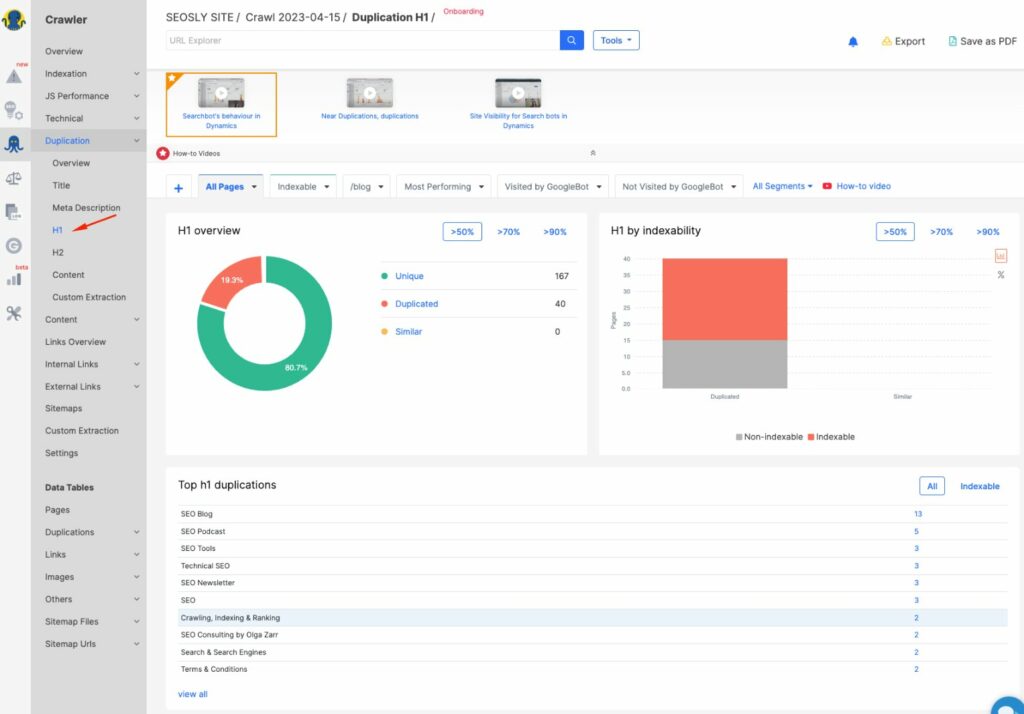
Duplicate H2
Similarly, the Duplicate H2 tab shows you pages with duplicate H2 tags.
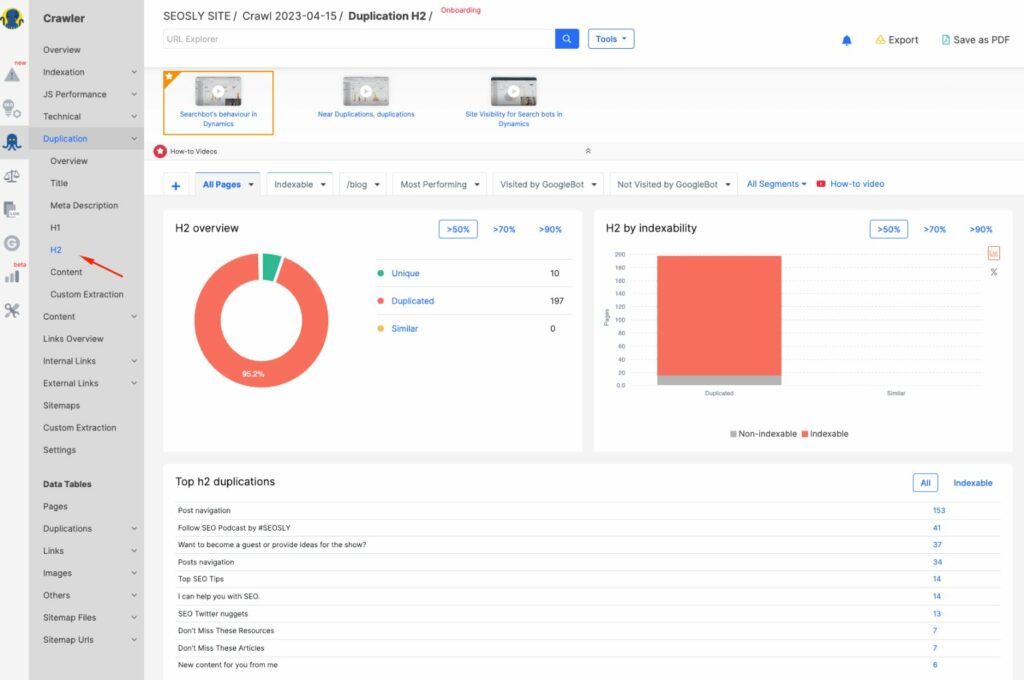
Duplicate Content
Finally, this tab highlights pages with exact or near-duplicate content in the body text.
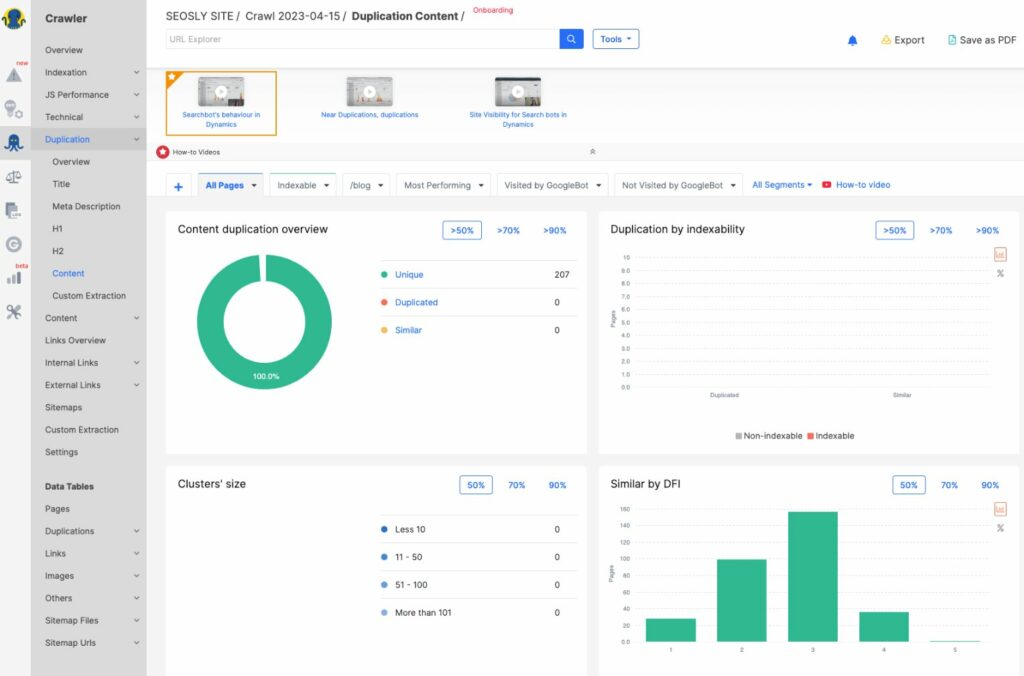
Knowing When Duplicate Content is Not an Issue
While duplicate content can cause issues with your website’s SEO, there are situations when it isn’t a concern.
Here are three scenarios where duplicate content doesn’t pose a threat to your website’s SEO:
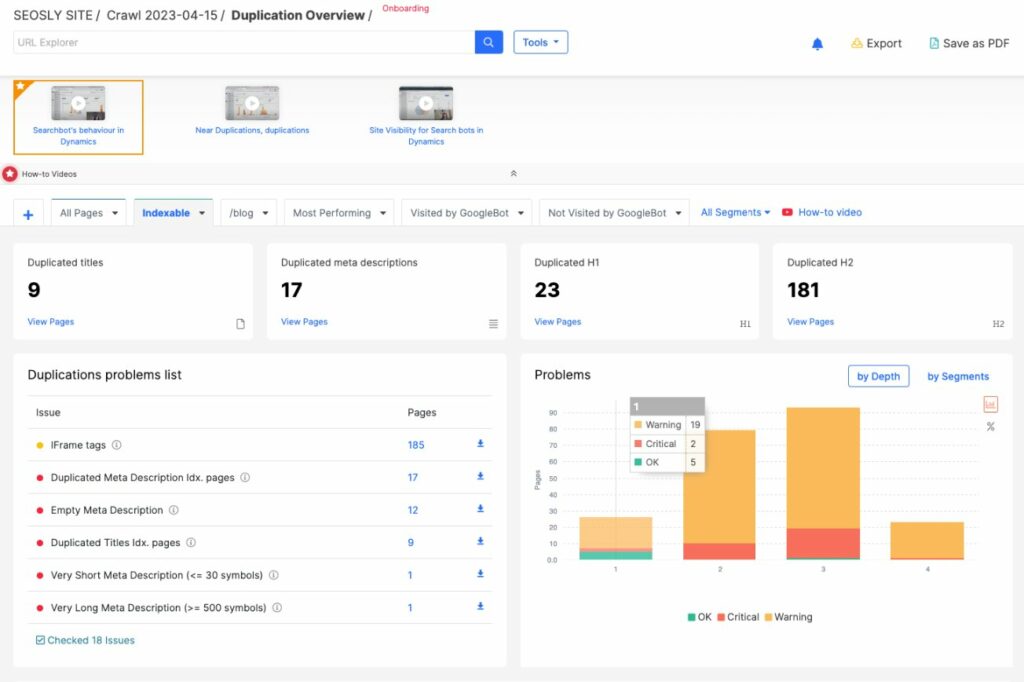
- Canonicalized pages: Similarly, if you have duplicate content on pages with a canonical tag pointing to the original source, search engines will understand that the duplication is intentional and will only index and rank the original, canonical version.
Keep in mind that Google treats
rel="canonical"as a hint and may choose a different canonical version of the page than the one you indicated.In JetOctopus and most website crawlers, canonicalized pages fall under the category of non-indexable pages.
- Pages you don’t want to rank: Sometimes, you may have duplicate content on pages that aren’t meant to rank in search engine results, like legal disclaimers, privacy policies, or terms and conditions.
In these instances, duplicate content isn’t a concern as it doesn’t affect your SEO strategy or goals.
In my case, these are SEO newsletter issues and SEO podcast notes. They are indexable but I don’t care about them having some duplicate content.
How to fix duplicate content issues
To fix duplicate content issues on your website, consider the following solutions:
Use canonical tags to point search engines to the original, preferred version of a page. Although Google treats canonical tags as a hint and may choose a different canonical URL, it’s still a good practice to use them.
Check the URL Inspection Tool in Google Search Console to see the canonical link Google has chosen for a given URL. This ensures that the original page is indexed and ranked while duplicates are consolidated.
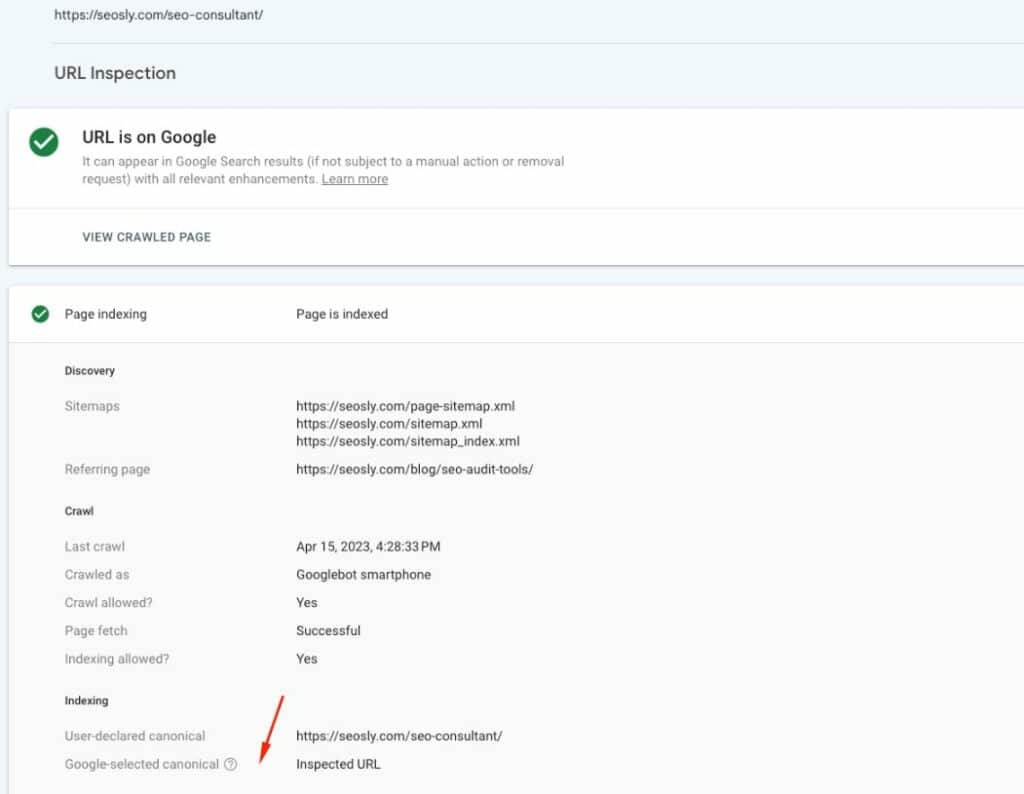
Create unique content for similar pages
Ensure each page on your website has a specific purpose and unique content. Refocus duplicate pages to target different keywords to make them distinct and valuable to users. This not only improves the user experience but also helps search engines differentiate between pages and rank them accordingly.
Redirect, merge, or remove duplicate pages
If you have multiple pages with identical content, consider using 301 redirects to guide users and search engines to the preferred version. You can also merge duplicate pages together by combining their content and adding 301 redirects from the removed pages to the consolidated ones.
Alternatively, delete duplicate pages. This will help search engines crawl and index your site more effectively. However, before deleting pages, make sure to check my guide on whether 404 errors harm SEO.
Frequently asked questions about duplicate content
Here are the most often-asked questions people have about duplicate content. They should beat the topic of content duplication to death.
What is duplicate content and why is it an issue for my website’s SEO?
Duplicate content refers to identical or nearly identical content appearing on multiple pages of your website. It can negatively impact your site’s SEO by confusing search engines and reducing your chances of ranking well.
What are the different types of duplicate content?
There are two main types of duplicate content: exact duplicates (completely identical content) and near-duplicates (content that is almost the same with slight variations).
How does duplicate content affect on-page SEO elements like meta titles, meta descriptions, H1, and H2 tags?
Duplicate content can confuse search engines and reduce your site’s chances of ranking well, as they may struggle to differentiate between pages with the same on-page SEO elements such as meta titles, meta descriptions, H1, and H2 tags.
Is there a duplicate content penalty from Google?
There is no direct penalty from Google for having duplicate content. However, duplicate content can still negatively impact your website’s rankings and visibility in search results.
What are the negative consequences of having duplicate content on my website?
Negative consequences of having duplicate content include difficulty for search engines to determine which version to index, diluted link equity, poor user experience, and wasted crawl budget.
When is duplicate content not an issue for my website?
Duplicate content is not an issue if it relates to non-indexable or canonicalized pages, or if it appears on pages you don’t want to rank, such as legal disclaimers or privacy policies.
How do I implement canonical tags to address duplicate content issues?
To implement canonical tags, add a rel="canonical" tag to the duplicate pages, pointing to the original, preferred version of the page. This helps search engines understand which page to index and rank.
How can I create unique content for similar pages to avoid duplication?
To create unique content for similar pages, ensure each page serves a specific purpose and refocus duplicate pages to target different keywords. This will help search engines differentiate between pages and improve user experience.
What are the best practices for redirecting or removing duplicate pages?
To address duplicate pages, you can use 301 redirects to guide users and search engines to the preferred version, merge duplicate pages by combining their content and adding 301 redirects from the removed pages to the consolidated ones, or delete duplicate pages to help search engines crawl and index your site more effectively. Before deleting pages, make sure to check the potential impact on SEO and ensure that you’re not causing unnecessary 404 errors.
How does duplicate content impact my website’s traffic and conversions?
Duplicate content can lead to reduced visibility in search results, as search engines may struggle to identify the most relevant page to rank. This can result in lower organic traffic and, consequently, a decrease in conversions. Additionally, duplicate content can lead to a poor user experience, as visitors may become frustrated when encountering the same content on multiple pages. This may cause an increase in bounce rates and a decrease in user engagement, negatively impacting your website’s overall performance.
Can I use internal linking strategies to mitigate duplicate content issues on my website?
Internal linking can play a role in addressing duplicate content issues by helping search engines understand the hierarchy and structure of your site. By carefully structuring your internal links, you can guide search engines to your most important pages and highlight the relationships between your content. This can help search engines identify the most relevant and unique pages on your site, reducing the impact of duplicate content. However, internal linking is not a standalone solution for duplicate content problems, and you should still consider implementing canonical tags, creating unique content, and merging or redirecting duplicate pages as needed.
How can I avoid creating duplicate content when using product descriptions from manufacturers?
If you’re using product descriptions from manufacturers, there’s a high likelihood that many other websites are using the same content. To avoid duplicate content issues, you can rewrite the product descriptions to create unique content for your website. Focus on providing additional value to your visitors by highlighting the product’s features and benefits, addressing potential customer concerns, and incorporating relevant keywords to improve SEO.
If I use quotes or excerpts from other websites, will it be considered duplicate content?
Using quotes or excerpts from other sources can be acceptable, provided that you give proper attribution to the original source and surround the quoted content with your own unique insights or commentary. However, if you rely heavily on quoted content or if the quotes make up a significant portion of your page, it may still be considered duplicate content by search engines. To minimize the risk, ensure that you add substantial original content to your pages alongside any quotes or excerpts.
Can my website’s SEO be negatively impacted by duplicate content found on other websites?
If other websites are copying your content without permission, it may lead to duplicate content issues that could potentially impact your website’s SEO. Search engines may have difficulty determining which version of the content to rank and display in search results. In some cases, the copied content might outrank your original content, which can lead to a loss of organic traffic. To protect your content and maintain your search engine rankings, consider using tools like Copyscape or Google Alerts to monitor the web for instances of content duplication. If you find your content being used without permission, you can request the infringing website to remove the content or give proper attribution through a backlink to your site.
Can images also be considered duplicate content?
While duplicate images don’t impact SEO as much as duplicate text content, it’s still a good idea to use unique images whenever possible. Search engines prefer fresh and original content, so using unique images can enhance user experience and potentially improve your rankings.
Does using boilerplate text lead to duplicate content issues?
Boilerplate text, such as footers, disclaimers, or legal information, is typically not considered duplicate content by search engines. However, ensure that the boilerplate text is not the main focus of the page and that there’s enough unique content on each page to differentiate it from others.
Does internal duplicate content harm SEO as much as external duplicate content?
Internal duplicate content, which occurs within your own website, is generally less harmful than external duplicate content found across multiple websites. However, it’s still crucial to address internal duplicate content to avoid diluting link equity, wasting crawl budget, and confusing search engines.
Is there a difference between duplicate and thin content?
Duplicate content refers to identical or nearly identical content appearing on multiple pages, whereas thin content refers to pages with little to no value or substance. While both types can negatively impact SEO, duplicate content primarily affects search engine indexing and ranking, while thin content may lead to poor user experience and lower engagement metrics.
Final words of wisdom
I hope this article has been helpful in guiding you on how to find and fix duplicate content issues on your website using JetOctopus. By following the steps I’ve outlined in this article, you can determine if your site has duplicate content and – more importantly – whether it is an issue.
If you found this article helpful, I’d appreciate it if you could share your thoughts or experiences in the comments below. I always value feedback from my readers and look forward to learning from your insights.
Thank you for taking the time to read my guide, and I wish you the best of luck in your SEO journey!
